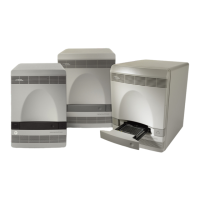DRAFT
September 25, 2007 1:07 am, 4376782_Glossary.fm
Glossary
141
Applied Biosystems StepOne
™
and StepOnePlus
™
Real-Time PCR Systems
Installation, Networking, and Maintenance Guide
CONFIDENTIAL — For AB Internal Use Only. Do Not Distribute.
experiment Refers to the entire process of performing a run using the StepOne
™
or StepOnePlus
™
systems, including setup, run, and analysis. The types of experiments you can perform
using the StepOne
™
and StepOnePlus
™
systems:
• Quantitation - standard curve
• Quantitation - relative standard curve
• Quantitation - comparative C
T
(∆∆C
T
)
• Melt curve
• Genotyping
•Presence/absence
experiment name Entered during experiment setup, the name that is used to identify the experiment.
Experiment names cannot exceed 100 characters and cannot include any of the following
characters: forward slash (/), backslash (\), greater than sign (>), less than sign (<),
asterisk (*), question mark (?), quotation mark ("), vertical line (|), colon (:), or
semicolon (;).
experiment type The type of experiment you are performing using the StepOne
™
or StepOnePlus
™
system:
• Standard curve
• Comparative C
T
(∆∆C
T
)
• Relative standard curve
• Melt curve (not available in the Design Wizard)
• Genotyping
•Presence/absence
The experiment type you select affects the setup, run, and analysis.
forward primer Oligonucleotide that flanks the 5′ end of the amplicon. The reverse primer and the
forward primer are used together in PCR reactions to amplify the target.
holding stage In the thermal profile, a stage that includes one or more steps. You can add a holding stage
to the thermal profile to activate enzymes, to inactivate enzymes, or to incubate a reaction.
housekeeping gene A gene that is involved in basic cellular functions and is constitutively expressed.
Housekeeping genes can be used as endogenous controls. See also endogenous control.
internal positive
control (IPC)
In presence/absence experiments, a short synthetic DNA template that is added to PCR
reactions. You can use the IPC to distinguish between true negative results (that is, the
target is absent in the samples) and negative results caused by PCR inhibitors, incorrect
assay setup, or reagent or instrument failure.
inventoried assays TaqMan
®
Gene Expression Assays and TaqMan
®
SNP Genotyping Assays that have been
previously manufactured, passed quality control specifications, and stored in inventory.
IPC In presence/absence experiments, abbreviation for internal positive control (IPC). In the
StepOne
™
software, the task for the IPC target in wells that contain the IPC and do not
contain IPC blocking agent. See also internal positive control (IPC).
IPC blocking agent Reagent added to PCR reactions to block amplification of the internal positive control
(IPC).
